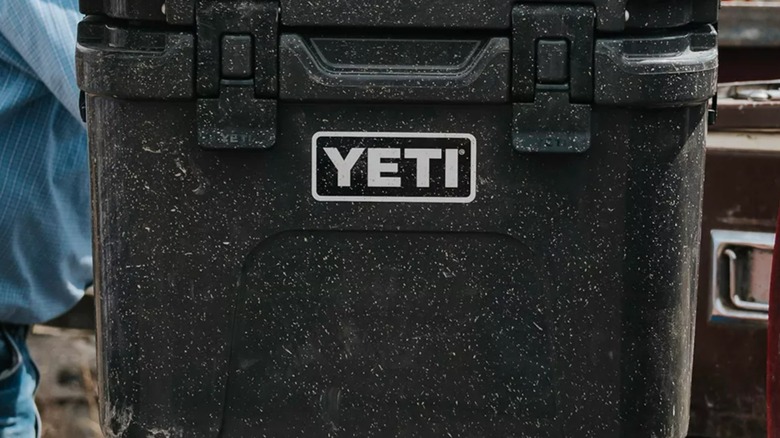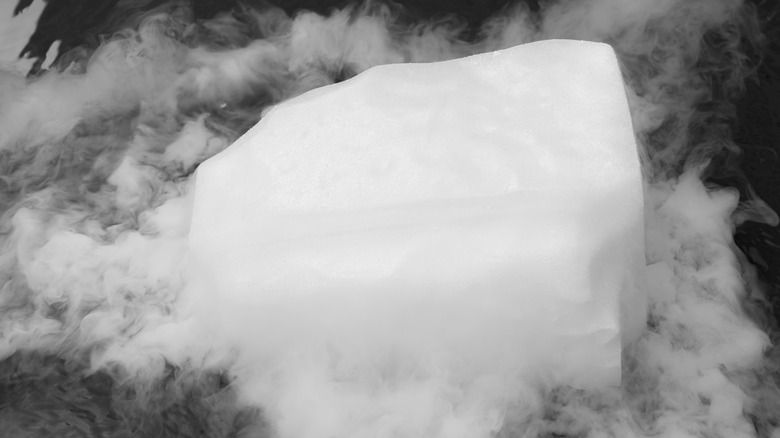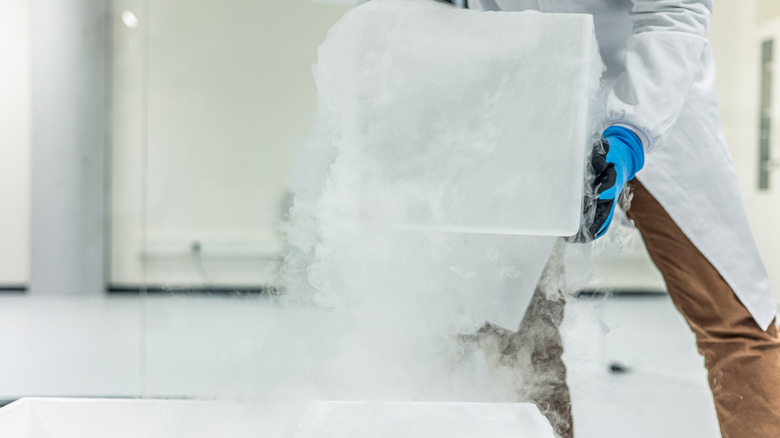Can You Put Dry Ice In A Yeti Cooler?
As the summer months unfold, two major changes happen: outdoor time becomes more common, and temperatures rise. Thus, when people go out for their latest beach trip, hike, or adventure, they're always looking for ways to beat the heat. Fortunately, there are plenty of must-have gadgets to keep you cool during increasingly high temperatures. Similarly, for those who want to bring food and drinks along but don't want them to spoil in the heat, coolers are your best friend. That is, so long as you use the right coolant to keep your meals fresh.
There are numerous cooler brands on the market, with Yeti being one of the most prominent. The company boasts several different cooler models, all more than capable of keeping whatever you choose to keep within them ice cold. If you're looking to use dry ice — a significantly colder and longer-lasting alternative to regular ice — however, you'll want to be sure of the model you have, as not all Yeti coolers can handle it. The Yeti website specifically states that the Tundra and Roadie Hard Coolers, as well as the Tank Ice Bucket, are the only Yeti products intended for use with dry ice. But just as important as knowing which Yeti product to use with dry ice is how to pack it right. It's not too involved a process, but it's worth going over for safety reasons.
How to safely use dry ice in a Yeti cooler
Dry ice calls for more caution than regular ice. It's frozen carbon dioxide and will cause serious injuries if it comes into contact with one's skin or is ingested. With that in mind, you should handle it with care when putting it into a Yeti cooler. You need to wear thick gloves and handle it in a well-ventilated area, allowing the carbon dioxide gas to dissipate effectively. With the right safety precautions taken, you're ready to pack your chosen Yeti unit with dry ice and get on with your day of leisure.
- Carefully wrap your dry ice in newspaper or cardboard, or place it in a paper bag. This prevents direct contact with your food.
- Decide where you want to place the dry ice in your cooler. It can go on top of everything or at the bottom.
- Place your Yeti cooler in a shaded or generally cool area to extend the life of your dry ice.
- If necessary, you can add regular ice for additional cooling.
Overall, dry ice is excellent for a cooler, along with a host of other scenarios. Dry ice could even save your car in an unexpected way. Still, it cannot be overstated how important it is to use the right type of cooler, Yeti or otherwise, with this substance.
Consequences of putting dry ice in the wrong cooler
There are multiple good reasons why only specific coolers, whether from Yeti or other major brands, are advertised as capable of withstanding dry ice. For one, there are physical limitations to non-dry ice-capable coolers. Due to dry ice's extremely low temperatures, unprepared coolers can warp or potentially crack from prolonged exposure. More dramatically, there's the threat of pressure buildup inside such a cooler. Without ample ventilation, carbon dioxide gas can build up inside a cooler, culminating in an explosion once that pressure reaches the unit's breaking point.
A cooler exploding due to the presence of dry ice is an extreme example of how it can harm those nearby. What's far less dangerous yet still entirely worth avoiding is the pain of touching a cooler that's not meant to have dry ice inside of it. A dry ice-compatible cooler will have interior insulation to keep the outside of the cooler from becoming painfully cold to the touch. Without it, there's a risk of freezer burn for anyone who makes contact with the cooler for too long.
If any of this dissuades you from using dry ice, traditional ice coolers are always an option, as is one of the many great electric coolers ready to take on your next camping trip. Dry ice undoubtedly has its risks, but overall, it's an excellent means of keeping your Yeti cooler and its contents nice and cold. Just remember to put it in the right unit, or your next outing could get dicey in a hurry.


